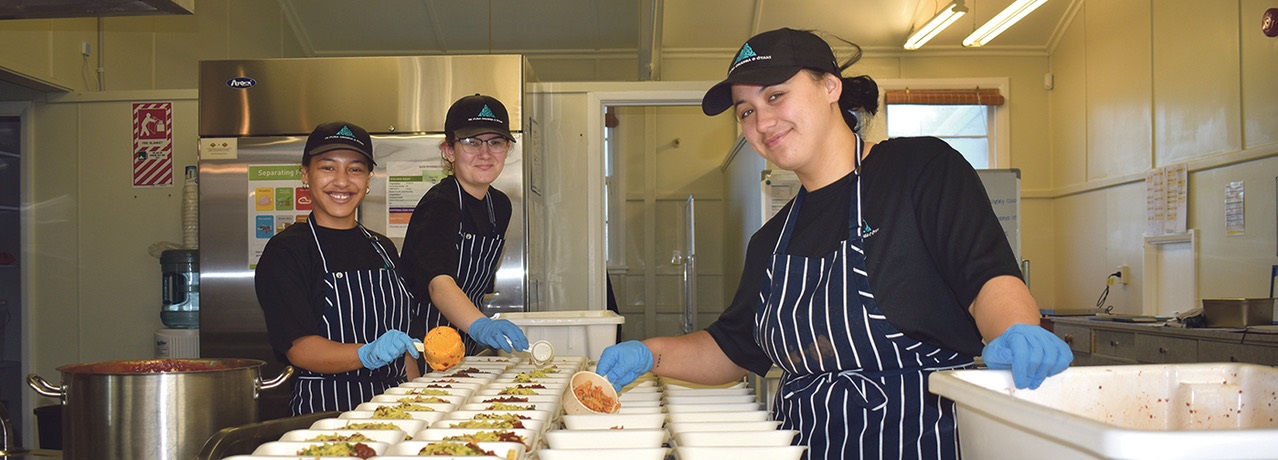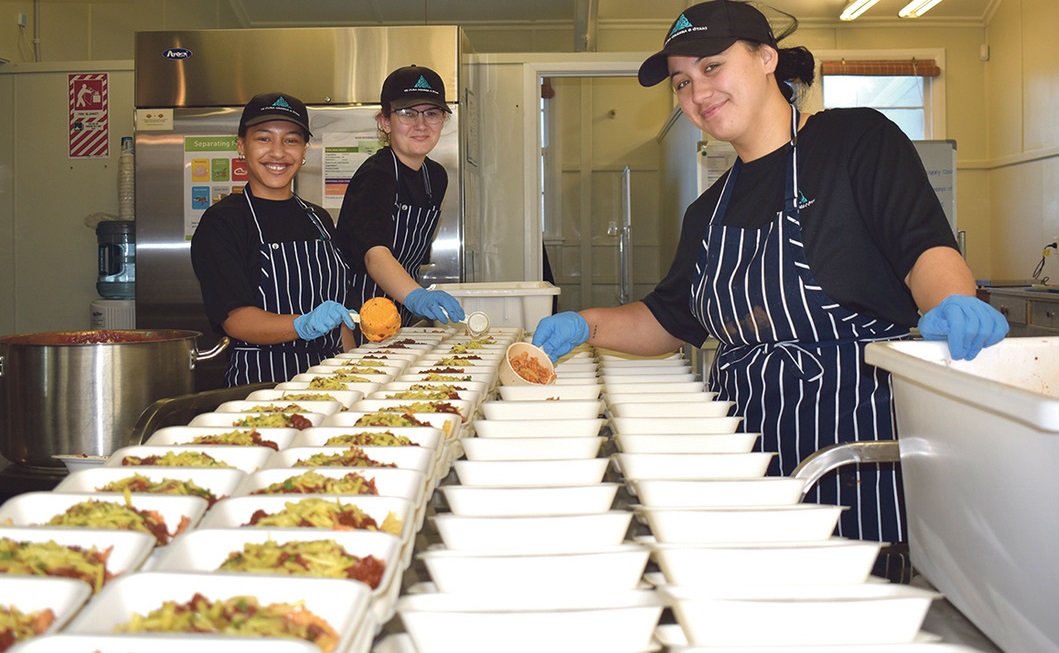
The kitchens at the old Ōtaki health camp are back serving children – this time not residents but children at schools throughout Ōtaki.
Te Puna Oranga o Ōtaki (TPOoŌ) has revived the old kitchens that now serve lunches to more than 700 children every school day, with another 300 produced at schools where commercial kitchens are available.
The meals are prepared by Te Puna Oranga staff, and provided fresh to students at Ōtaki College, Ōtaki School, St Peter Chanel, Te Kura Kaupapa Māori o Te Rito, and in term two, to Waitohu School.

Spaghetti bolognese goes into school lunch boxes prepared by, from left, Trinity Cook, Livvy Murray and Te Wairere Hapeta-Millam.
Photo Ōtaki Today
Funding comes from the Ministry of Education’s Ka Ora, Ka Ako (Healthy School Lunches) programme, under an iwi/hapū supplier model.
Lunches were previously supplied by a national, centralised provider.
Te Puna Oranga o Ōtaki kaiwhakahaere (general manager) Heniti Buick says the move to a local supplier has improved communication and delivery, allowing TPOoŌ to incorporate feedback and change almost immediately, boosting the uptake and popularity of the lunches.
She says TPOoŌ worked alongside Ngā Hapū o Ōtaki and others before starting the programme.
“For me, the job has been made a lot easier because I was talking to people I know – all my aunties. They’ve supported us all the way.”
Heniti’s first-hand knowledge of healthy foods has also been an advantage. She has a bachelor of science with a post-graduate degree in dietetics at Otago University, and has worked as a clinical dietitian.
Te Puna Oranga began making the school lunches, based on Ministry of Education nutrition guidelines, in late 2022, firstly for St Peter Chanel School. From 20 lunches initially, the numbers grew as schools were added, to the point where there are now more than 1000 fresh lunches prepared every school day.
Establishing the local programme wasn’t a straight-forward task.
A commercial kitchen was required that could handle the huge volume. The one at the health camp was available, but all the equipment disappeared when the camp closed in 2018. A lease was arranged with tenant Kiwi Can Do, camp owner the Department of Conservation, and guardians Ngā Hapū o Ōtaki. Then a complete kitchen fitout was required, which was a huge job.
Next came staffing, which has grown to 10, including food manager Claudia Gray.
Deliveries are made using a truck supplied by Chris Thomsen Motors, but purchase of a dedicated school lunch van is on the agenda. Some schools have their own kitchen, so meals can be prepared on-site.
Heniti has clearly enjoyed the journey.
“We’ve been able to put together nutritious meals that are delivered fresh – hot or cold – to our tamariki,” she says. “They taste good and they look good, not like something you’re going to feed to your cat.”
Special dietary requirements are also catered for, with about 50 meals prepared separately.
Feedback for the programme has been encouraging.
“Parents are telling us their children’s diet has changed,” Heniti says. “They’re trying new things at school, which means they’re prepared to try healthy foods at home.
“Kids who ate a very limited range of foods that are usually bad for them are eating nutritious foods now.”
Anecdotally, children have also been calmer and less agitated at school and at home.
With more food being consumed and not turned away, wastage is minimal. Even on the rare occasions when too many meals are delivered – for example when a class trip has not been advised – the meals go to local kaumātua in need who appreciate getting something they’ve not had to prepare themselves.
OTHER STORIES
LATEST POSTS
- Yilin Ōtaki College dux
- No respite for ‘cone town’
- Trout spawn in Winstone Lakes
- Two more in Hall of Fame
- Rāhui Rd next in line for road works
- ‘Monkey’ back to old tricks
- Ōtaki dominates awards night
- Sam risks all for Gaza
- High Court confirms iwi rights
- Heniti ‘proud to call Ōtaki home’
- Infrastructure works keep rolling on
- An ONZM for arts, sport, heritage
- Trappers aim for predator free Te Horo
- ‘No Ōtaki consultation’ on polyclinic
- Deal puts teaching in iwi hands
- Te Horo hall wants land for car park
- Beach burglars pinch trailer and tools
- Toilet vandalism ‘tragic, sad’
- Fifty years for Ōtaki fire chief
- WRM vision celebrated after 50 years
- Idiots in cars’ block highway
- Oiroa Kaihau – a focused career soldier
- ‘Aunty Gabe’ Rikihana gone at 98
- Te Horo Hall opens for ‘future generations’
- Demographic shift offers ‘new opportunities’
- Kite magic returns to Ōtaki skies
- Crowds out for Waitangi Day
- Marian retires from women’s club
- Moy developers seek judicial review
- New tumuaki at Wānanga
- Charlie beats the odds
- Rescuers seek funds
- Ōtaki Rotary winds up after 60 years
- Czech president visits Te Horo kilns
- Waitohu students get peek at reservoir
- Kids get koha for good
- Waikawa residents petition to save footbridge
- Cr’s fireworks spark neighbourhood ire
- Bert celebrates 100th birthday
- Dux Louis looks to the stars
- Aunty Hira gone, aged 92
- New GP service on the way
- A touch of class in beach bus
- Te Horo bus stop sites confirmed
- Terama rides for charity
- Whitebait season gets under way
- Eric’s innings falls just short of century
- New Te Horo wetland taking shape
- Principals dispute MP’s maths claims
- Dumping threatens estuary ecosystem

